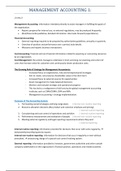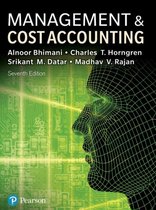Summary
Management Accounting 1 for Business SUMMARY (management & cost accounting) Midterm
- Course
- Institution
- Book
English summary for the course Management Accounting 1 For Business of the bachelor Business Administration at the UvA. It includes all the required chapters and additional lecture notes. It mostly discusses the required theory, as well as some calculations and exercises, but you obviously have to ...
[Show more]




